5G Network
In order to meet user requirements, and at the same time to overcome the challenges of the 5G network, it was necessary to change the approach to designing the architecture of the cellular network itself. It turned out that about 80% of the time the wireless network user is indoors. In current wireless networks, the base station is located in the center of the cell, and it does not take into account whether the user equipment is located indoors or outdoors. If it is located indoors, great losses occur during signal penetration between the base station and the user, most often through the walls of buildings. For this reason, the 5G architecture distinguishes between indoor and outdoor installations. Thanks to this, it is possible to significantly reduce signal penetration losses through a fixed obstacle. [V10] This principle can be seen in Figure 1, while the interior installation can be seen in the lower left part of the image. The architecture consists of two systems, namely the radio access network - RAN, and the mobile core. RAN manages the radio spectrum, ensures that it is used efficiently and that it meets the requirements of quality of service - QoS for each user [V12].

Fig. V1: Basic scheme of 5G network [V11].
A mobile core is a collection of functions, usually in the form of one or more devices, that serves multiple purposes, such as:
- Verifying devices before connecting them to the network
- Provides Internet connection for both data and voice services
- Ensures that this connection meets QoS requirements
- Tracks user movement to ensure uninterrupted service
- Monitors the use of subscriber services for invoicing and billing purposes[V12]
Figure V2 shows a simplified view of this architecture for a 4G network, eNBs are located within the RAN in the case of a 4G network. In the 5G network, these base stations are known as gNB, while the letter "g" stands for "next generation".